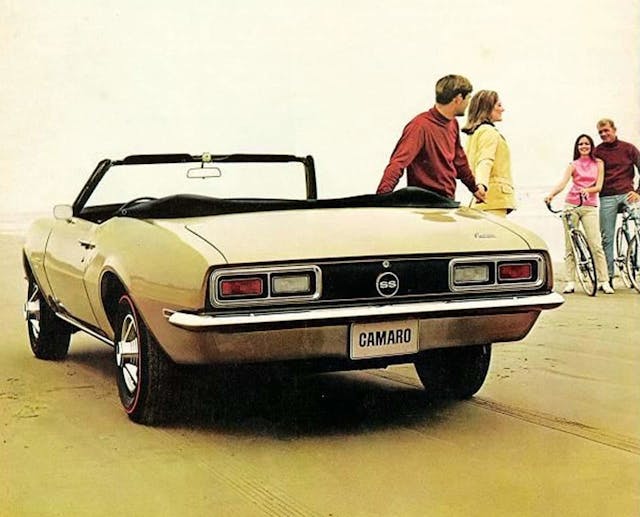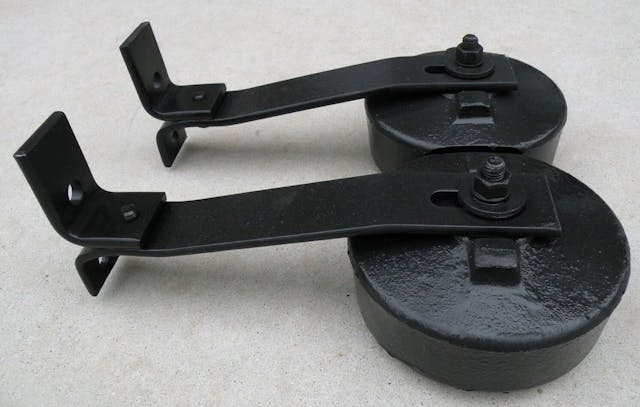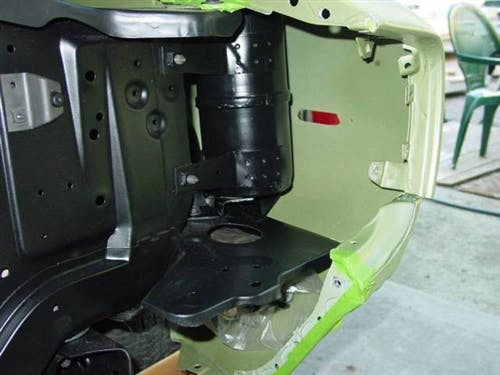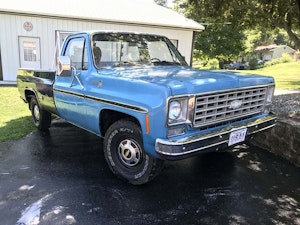Media | Articles
Cocktail Shakers: Maybe on a Cadillac or Rolls-Royce, but a Camaro?

Despite the known dangers of putting ethanol in your own tank before driving—as opposed to putting it in your car’s gas tank—there have been some official associations between alcohol and automobiles. The 1957 Cadillac Eldorado Brougham came with a custom minibar in the glovebox. If you have the means to own a Rolls-Royce Ghost, you can order it with a “Coolbox” installed at the Goodwood works that keeps the bubbly chilled (for backseat passengers only, one presumes) and has dedicated storage for a couple of champagne flutes.


You might think, then, that when vintage Camaro enthusiasts talk about “Cocktail Shakers” in their convertibles, they might be discussing something similar, but in this case the term has nothing to do with the fruit of the vine or its grain-based cousins in the EtOH family. It has to do with how Detroit automakers did a clever bit of “engineering by afterthought.”
Most of us probably think of our car’s roof as being there to protect us from the elements, but the roof is a structural element. Removing the roof to make a convertible (or cutting a big hole in the back of the body to make a hatchback) decreases the body’s overall stiffness. That’s obviously an issue when a vehicle uses monocoque or unibody construction, but even convertibles with body-on-frame designs can exhibit symptoms of their bodies flexing like cowl shake. Every structure has one or more resonant frequencies. Those resonances can create an oscillating feedback loop that results in vibrations that the driver and passenger can feel.
During the development of the first-generation Camaro’s convertible iteration, when then recently-installed Chevrolet General Manager Pete Estes was given a ride in an early prototype at the General Motors Proving Grounds near Milford, Michigan, the new boss found the vibrations to be unacceptable for a production vehicle. Estes tasked his engineers with immediately finding a solution.

Normally, the solution would be to make the mid-section of the body less flexible, but while conventional methods like reinforcing rocker panels and stiffening the floor ameliorated the shaking, it didn’t completely solve the problem. Eventually, Estes’ team came up with something that had earlier been used on Chevy’s own Corvair, similar to how Ford engineers had addressed the torsional vibration of the early-1960s Ford Thunderbird and Lincoln Continental convertibles (which shared a platform). Rather than address the bodies’ flexibility, the engineers attacked the vibrations. Since the vibrations were the result of resonant frequencies, they realized that if they could effectively dampen those frequencies, they could not cause the vibrations. In the case of the Conti, Ford engineers mounted weights on the end of what are essentially leaf springs in each corner of the car’s body. The assembly is acoustically tuned to the body’s resonant frequency, and when the body is subjected to loading, the energy from that loading, which would normally start the feedback loop of oscillations, is instead absorbed by the damper.

The early-’60s Continental and T-Bird are large cars, with substantial body overhangs front and rear, so there’s no problem fitting in and hiding the relatively long mechanical dampers. Corvairs and Camaros, though, are relatively compact, so for the redesigned 1965 Corvair convertible, Chevy engineers put a weight on a coil spring inside a sealed cylinder filled with automatic transmission fluid, all tuned to the body’s resonant frequency. The sprung weight would dampen the body’s vibrations while the ATF would dampen the motion of the weights. The motion of the weight inside the cylinder is not unlike the contents of a cocktail shaker, hence the nickname. The capsule ended up being small enough to be tucked vertically in the corners of the body.

At the next demonstration of the Camaro convertible, when engineers took their boss for a ride, Estes was very pleased with the lack of vibration. He wasn’t as happy when he found out about the solution. Not only was he reported to be vocally disappointed in what he considered to be an inelegant, albeit clever, solution, the four canisters added about 100 lbs to the weight of what was supposed to be a sporting automobile. Estes tasked the engineers with coming up with a better solution, but they were never able to replace the Cocktail Shakers before the convertible Camaros were discontinued when the second-gen Chevy pony car was introduced as a mid-year 1970 model.
While you may be able to buy a complete, new reproduction convertible body for your first-generation Camaro, sourcing the Cocktail Shakers might be a bit more difficult, as they are long since out of production and nobody appears to be manufacturing repro units. GM made about 60,000 first-gen Camaro ragtops, so used dampers can be found, though they are getting rarer.
Installing used units shouldn’t be a problem, as it is a very simple mechanical device, and the only things that can go wrong are a broken spring or leakage of the ATF. They’re also not prohibitively expensive. Advertised prices are between $125 and $500 each (try Camaro Central and Heartbeat City).
***
Marketplace
Buy and sell classics with confidence
Check out the Hagerty Media homepage so you don’t miss a single story, or better yet, bookmark it. To get our best stories delivered right to your inbox, subscribe to our newsletters.















Very cool!
I had no idea that such solutions were employed.
Insofar as negating a resonant frequency, could an audio speaker playing a single specific tone also be used? It’d be cheaper and lighter than what they did.
The article is referring to a mechanical resonance (as when soldiers marching across a bridge break step) which is vastly different than a sound wave.
I recall these in the old cars.
Another rare option was traction squirters in the rear wheel wells. It was to spray deicer but I had heard some would put bleach in it for burn outs.
That was my parent’s generation! Everything with the cigarettes and drinking! Out of four people in my immediate family, I was the only one who wasn’t an alcoholic! But they earned the right to ruin their health because of the sacrifices their generation made during the war!
It’s a “damper.” A dampener sprays a liquid.
You are right! Thanks for this, we have edited accordingly.
Maybe they sprayed a liquid when they leaked! I always thought they were there for balance.
I bet the spray was a rust proofing feature!
Even though they’re incorrectly labeled as “dampeners” on the GM assembly page!
I did not know about the Camaro cocktail shakers. Didn’t know that they did that on the car.
how does this relate to center of percussion law? old Three Muskateer Chrysler trick to smooth out ride.
I have a 69 pacecar with these and yes they are heavy. Convertibles, especially on unibody cars, have always been a flexibility challenge. The 79-85 FWD Riv, Toro, Eldo conv. doors would jamb up if you parked it on an uneven spot. The Reatta conv. had weights added to the rear to dampen the vibration. They were so bad that everyone of them was taken to Fla to section on I-75 and driven at 70-75 mph. If the shake was bad enough the car was scrapped.
I took them out of my 69 Camaro as soon as I realized how heavy they are since I drag raced it occasionally. Never noticed any of the symptoms they were supposed to fix so never put them back. Some 40+ years later they’re still out but I know exactly where they are.
What about the Firebird. I had a ’69 convertible and don’t recall seeing these. Was the pontiac sufficiently different to not need them?
It had them but they’re tucked neatly into the extreme corners of the car, painted the same color.
When I bought my 67 convertible in 1981 it had a bad vibration that felt like the whole body was twisting. The cocktail shakers weren’t all there, so I took them out. Didn’t like the extra weight. I then replaced the bias ply tires with radials. Problem solved!
Yes the “cocktail shaker” damper was first used in the second generation 65 to 69 Corvair convertible. Oddly the earlier Corvair convertibles DID NOT use them and there is no known issue with vibration. Of course the earlier Corvairs used a thicker sheet metal for the body vs. the 65 – 69 Corvairs. GM started using the thinner sheet metal around 1965 and it was noticeable via increased body flex.
BTW the Corvair units use different mounting brackets so it would not be easy to adapt them to the Camaro. Also the Corvair rear units are often missing. It is thought they are removed when any rear body damage is repaired. They are HEAVY and awkward to install in the back.
Chevy was not the first automaker to use these. Deusenberg pioneered these back in 1928, installing one at both ends of both bumpers. (They were design-integrated into the rolled bumper ends so as to be almost invisible.) Walt Chrysler, never one to be shy of copying a good idea, promptly applied the principle to the Imperials and Chryslers. By the mid-1930s Hudson, Pierce-Arrow and Packard all had joined the bandwagon. The beauty of the Deusenburg design was: the faster the car went, the more the fluid in the dampers would oscillate – damping vibration at any speed.
Well Citroen used them on the 2cv from 1948, one at each wheel..same principle, a sprung weight inside a canister. Called a batteur